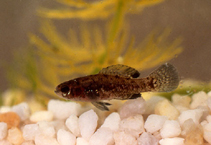Elassoma evergladei Jordan, 1884
Everglades pygmy sunfish
Add your observation in Fish WatcherAquaMaps webservice down at the moment
Upload your photos and videos
Pictures | Google imageElassoma evergladei
Picture by Page, L.M.
Pictures | Google imageElassoma evergladei
Picture by Page, L.M.
Classification / Names Nomi Comuni | Sinonimi | Catalog of Fishes(Genere, Specie) | ITIS | CoL | WoRMS | Cloffa
> Centrarchiformes (Basses) > Elassomatidae (Pygmy sunfishes)
Etymology: Elassoma: Greek, elasson = smaller + Greek, soma = body (Ref. 45335).
More on author: Jordan.
Etymology: Elassoma: Greek, elasson = smaller + Greek, soma = body (Ref. 45335).
More on author: Jordan.
Environment: milieu / climate zone / depth range / distribution range Ecologia
; acqua dolce demersale; pH range: 7.0 - 7.5; dH range: 8 - 12. Temperate; 10°C - 30°C (Ref. 1672); 35°N - 27°N
Distribuzione Stati | Aree FAO | Ecosystems | Presenze | Point map | Introduzioni | Faunafri
North America: USA from Cape Fear River drainage in North Carolina to Mobile Bay in Alabama; south in Florida to northern edge of Everglades.
Size / Peso / Age
Maturity: Lm ? range ? - ? cm
Max length : 3.4 cm TL maschio/sesso non determinato; (Ref. 5723); common length : 2.3 cm TL maschio/sesso non determinato; (Ref. 12193)
Max length : 3.4 cm TL maschio/sesso non determinato; (Ref. 5723); common length : 2.3 cm TL maschio/sesso non determinato; (Ref. 12193)
Occurs in swamps, heavily vegetated sloughs and small sluggish streams, usually over mud. Feeds on worms and crustaceans (Ref. 7020). Oviparous, eggs are deposited in aquatic vegetation, preferably on strands of Ceratophyllum sp. when available (Ref. 58020).
Life cycle and mating behavior Maturità | Riproduzione | Deposizione | Uova | Fecundity | Larve
Male guards the eggs (Ref. 58020). Produces 40-60 eggs.
Main reference
Upload your references | Bibliografia | Coordinatore | Collaboratori
Page, L.M. and B.M. Burr, 1991. A field guide to freshwater fishes of North America north of Mexico. Houghton Mifflin Company, Boston. 432 p. (Ref. 5723)
IUCN Red List Status (Ref. 130435: Version 2024-2)
Least Concern (LC) ; Date assessed: 29 November 2011
CITES
Not Evaluated
Threat to humans
Harmless
Human uses
Pesca: commerciale; Acquario: Commerciale
FAO - Publication: search | FishSource |
Informazioni ulteriori
Population dynamics
Growth parameters
Max. ages / sizes
Length-weight rel.
Length-length rel.
Length-frequencies
Mass conversion
Reclutamento
Abbondanza
Growth parameters
Max. ages / sizes
Length-weight rel.
Length-length rel.
Length-frequencies
Mass conversion
Reclutamento
Abbondanza
Life cycle
Riproduzione
Maturità
Maturity/Gills rel.
Fecundity
Deposizione
Spawning aggregations
Uova
Egg development
Larve
Dinamica popolazioni larvali
Riproduzione
Maturità
Maturity/Gills rel.
Fecundity
Deposizione
Spawning aggregations
Uova
Egg development
Larve
Dinamica popolazioni larvali
Anatomy
Area branchiale
Brain
Otolith
Area branchiale
Brain
Otolith
Physiology
Body composition
Nutrients
Oxygen consumption
Swimming type
Swimming speed
Visual pigments
Fish sound
Diseases & Parasites
Toxicity (LC50s)
Body composition
Nutrients
Oxygen consumption
Swimming type
Swimming speed
Visual pigments
Fish sound
Diseases & Parasites
Toxicity (LC50s)
Human related
Aquaculture systems
Profili di acquacoltura
Varietà
Ciguatera cases
Stamps, coins, misc.
Aquaculture systems
Profili di acquacoltura
Varietà
Ciguatera cases
Stamps, coins, misc.
Strumenti
Bio-Quiz | E-book | Giuda pratica | Generatore frequenze di lunghezza | Strumento Parametri Biologici | Mappa dei ritrovamenti | Classification Tree
| Catch-MSY |
Special reports
Download XML
Fonti Internet
AFORO (otoliths) | Aquatic Commons | BHL | Cloffa | BOLDSystems | Websites from users | Check FishWatcher | CISTI | Catalog of Fishes: Genere, Specie | DiscoverLife | ECOTOX | FAO - Publication: search | Faunafri | Fishipedia | Fishtrace | GenBank: genome, nucleotide | GloBI | Google Books | Google Scholar | Google | IGFA World Record | MitoFish | Otolith Atlas of Taiwan Fishes | PubMed | Reef Life Survey | Socotra Atlas | Tree of Life | Wikipedia: Go, ricerca | World Records Freshwater Fishing | Zoobank | Zoological Record
Estimates based on models
Phylogenetic diversity index (Ref. 82804): PD50 = 0.5156 [Uniqueness, from 0.5 = low to 2.0 = high].
Bayesian length-weight: a=0.00550 (0.00207 - 0.01457), b=3.14 (2.91 - 3.37), in cm total length, based on LWR estimates for this (Sub)family-body shape (Ref. 93245).
Trophic level (Ref. 69278): 3.3 ±0.40 se; based on food items.
Resilienza (Ref. 120179): Basso, tempo minimo di raddoppiamento della popolazione 4.5 - 14 anni (Fec=25).
Fishing Vulnerability (Ref. 59153): Low vulnerability (10 of 100).




